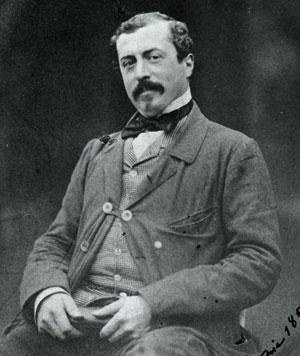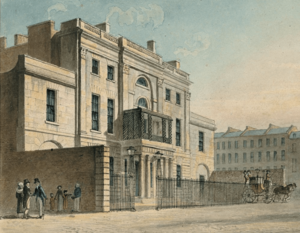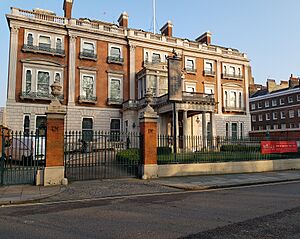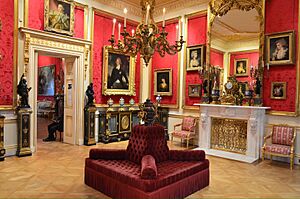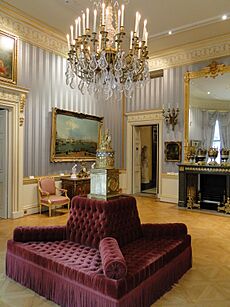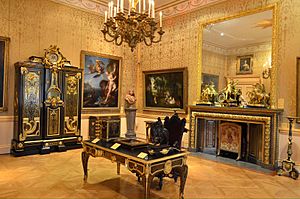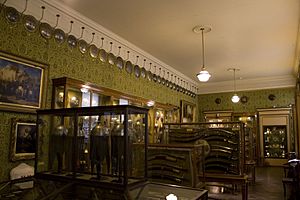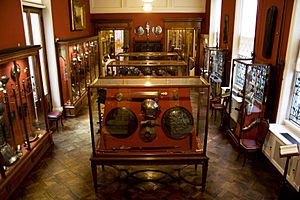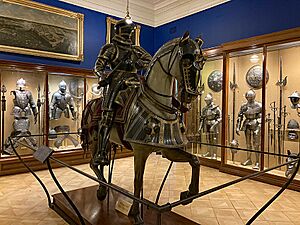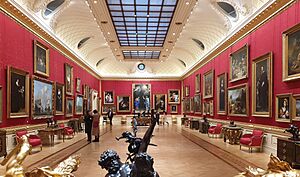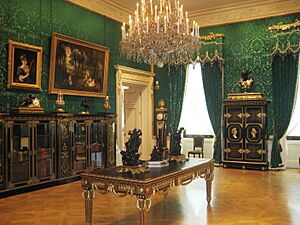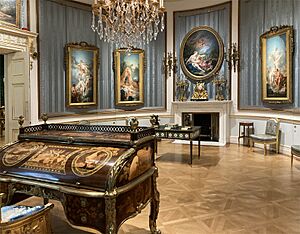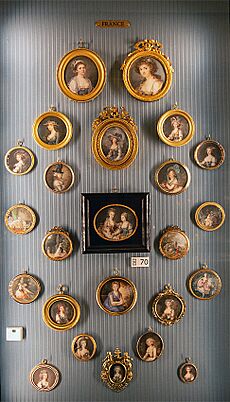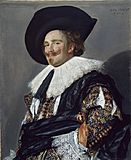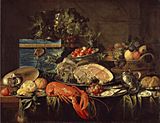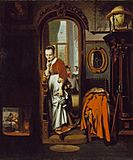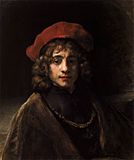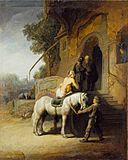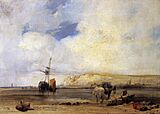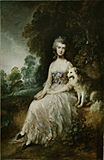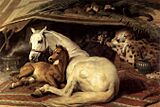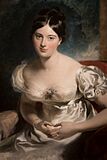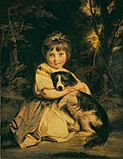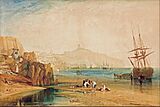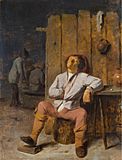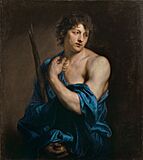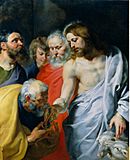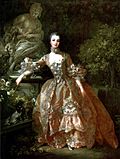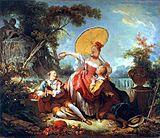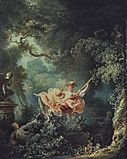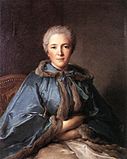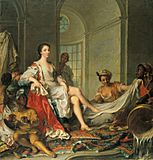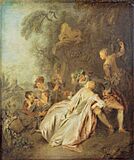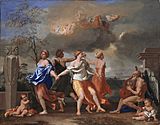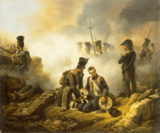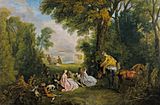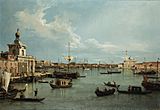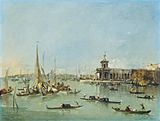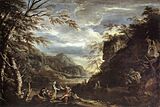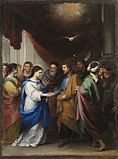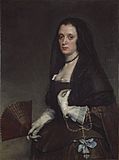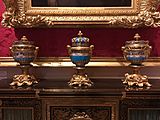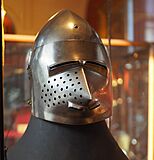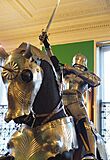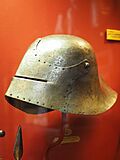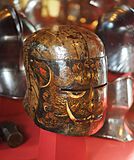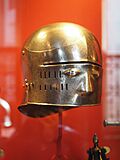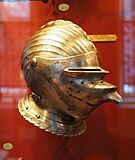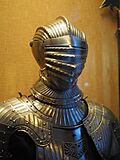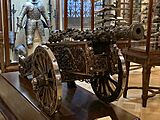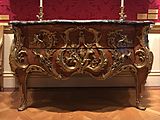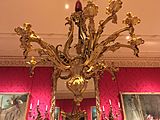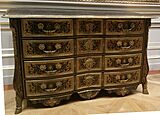Wallace Collection facts for kids
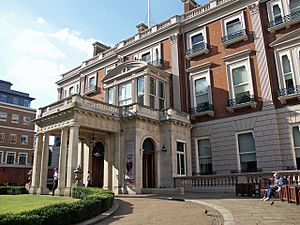
Front entrance of the main building
|
|
| Lua error in Module:Location_map at line 420: attempt to index field 'wikibase' (a nil value). | |
| Established | 1897 |
|---|---|
| Location | Manchester Square London, WC1 United Kingdom |
| Collection size | approx. 5,500 objects displayed in 30 galleries |
| Visitors | 419,020 (2016) |
| Public transit access | |
The Wallace Collection is a fantastic museum in London. It's located in a beautiful old building called Hertford House. This house used to be the home of a very important family, the Marquesses of Hertford. The museum is named after Sir Richard Wallace. He, along with the Hertford family, collected thousands of amazing artworks between the 1700s and 1800s.
The collection features beautiful paintings and decorative arts from the 15th to the 19th centuries. You can see many French 18th-century paintings, fancy furniture, cool arms and armour, delicate porcelain, and paintings by famous old masters. All these treasures are displayed in 25 different rooms. The best part is that the museum is open to everyone, and entry is completely free!
The museum officially opened in 1897. It was created from the private collection of Richard Seymour-Conway, 4th Marquess of Hertford (1800–1870). He left his collection and the house to his son, Sir Richard Wallace (1818–1890). Later, Sir Richard's wife, Julie Amelie Charlotte Castelnau, decided to give the entire collection to the British nation. The museum opened its doors to the public in 1900 at Hertford House, and it's been there ever since. For a long time, nothing from the collection could ever leave the museum. However, in 2019, the rules changed a little, allowing some items to be lent out for special exhibitions.
The United Kingdom has many incredible artworks from old French times. These were bought by rich families after the French Revolution. The Wallace Collection, along with Waddesdon Manor and the Royal Collection, are some of the biggest and most important collections of French 18th-century decorative arts in the world. They are almost as grand as the collections in France itself, like the Musée du Louvre and Château de Versailles. The Wallace Collection is managed by the government, and its current director is Xavier Bray.
Contents
History of the Collection
The Wallace Collection shows off amazing artworks gathered over many years by a rich British family. Five generations of the Hertford family and Sir Richard Wallace, who was the son of the 4th Marquess, helped build this collection. In the 1800s, the Marquesses of Hertford were one of the richest families in Europe. They owned huge properties across England, Wales, and Ireland. They also became even wealthier through smart marriages.
While they weren't the most important politicians, the 3rd and 4th Marquesses and Sir Richard Wallace became leading art collectors of their time. The Wallace Collection has about 5,500 artworks. Lady Wallace gave this entire collection to the British nation in 1897. The government then decided to buy Hertford House to display the collection, and it opened as a museum in 1900.
The museum is especially famous for its 18th-century French art. This includes paintings, furniture, porcelain, sculptures, and gold snuffboxes. It also has paintings from the 16th to 19th centuries by artists like Titian, Van Dyck, Rembrandt, Hals, Velázquez, Gainsborough, and Delacroix. You can also see a collection of arms and armour, and medieval and Renaissance objects like Limoges enamels, maiolica, glass, and bronzes. The paintings, furniture, and porcelain are displayed together, just like they would have been in private homes in the 1800s.
Hertford House: The Museum Building
Early Hertford House
The original Hertford House from the 1500s and 1600s was in a different part of London called Cannon Row. It was the London home of Edward Seymour, 1st Earl of Hertford. His father, Edward Seymour, 1st Duke of Somerset, who was Queen Jane Seymour's brother, started building a huge house called Somerset House. But he didn't live to see it finished.
Hertford House in Manchester Square
The building you see today in Manchester Square was built in 1776. It was designed for George Montagu, 4th Duke of Manchester, who owned the land around it. It was first called "Manchester House." From 1791 to 1795, it was even used as the Spanish Embassy!
In 1797, Francis Ingram-Seymour-Conway, 2nd Marquess of Hertford, bought the lease. He hosted a huge ball there in 1814 for European leaders after Napoleon's first defeat. The 3rd Marquess, Francis Seymour-Conway, 3rd Marquess of Hertford, who was the family's first big art collector, mostly lived in other London homes.
His son, Richard Seymour-Conway, 4th Marquess of Hertford, added even more art to the collection. He lived mostly in Paris and rarely visited Hertford House. The house was mainly used to store his growing art collection. He passed away in Paris in 1870 without any direct children. His titles and estates went to a distant cousin.
However, his son, Sir Richard Wallace, 1st Baronet, inherited his art collection and other properties. In 1871, Sir Richard bought the lease for Hertford House back from the 5th Marquess. He moved back to England from Paris, bringing much of the art collection with him. This was because of the difficult political situation in France after the Siege of Paris. Sir Richard Wallace also added to the collection, buying medieval and Renaissance objects, and European arms and armour.
Between 1872 and 1882, Sir Richard Wallace made many changes to the house. He added a new section at the back to hold his art. He also added a new front entrance and changed the windows. The whole building was given a red brick look. Sir Richard left everything to his wife. She then gave the main art collection to the nation, creating the "Wallace Collection." The government bought Hertford House to be the museum's home. Hertford House first opened as a museum on June 22, 1900.
In 2000, the inner courtyard was covered with a glass roof, and a restaurant called "Cafe Bagatelle" was opened there. The museum doesn't try to look exactly like it did when Sir Richard and Lady Wallace lived there.
Inside the Museum
Ground Floor Highlights
Entrance Hall
The Entrance Hall has marble statues of the three main people who created the Wallace Collection. These are Richard Seymour-Conway, 4th Marquess of Hertford, his son Sir Richard Wallace, and Lady Wallace. Lady Wallace gave the entire collection to the British nation in 1897. This room still looks much like it did when Sir Richard Wallace lived here.
Front State Room
Displays: Portraits and Porcelain
This room shows how grand a London townhouse was in the 1870s. It helps visitors imagine what it was like to visit the Wallace Collection when it was a home. The State Rooms were the most impressive rooms, used to welcome important guests. Today, this room is filled with portraits, just as it was in 1890.
Back State Room
Displays: Rococo Art of Louis XV The Back State Room is now dedicated to the art style called rococo. This style was popular during the time of King Louis XV and his famous mistress, Madame de Pompadour. You can see some of the best rococo art in the Wallace Collection here. Sir Richard Wallace used this room to entertain his guests. A large chandelier from 1751, made by Jacques Caffiéri, is still in the room.
Dining Room
Displays: 18th-Century Still Lifes and Portraits This room features amazing French 18th-century portraits by Nattier and Houdon. You can also see two oil sketches by Jean François de Troy. These were shown to King Louis XV for his approval to decorate his dining room.
Billiard Room
Displays: Decorative Arts under Louis XIV
Oriental Armoury
Displays: East European, Turkish, and Indo-Persian Arms and Armour The Oriental arms and armour in the Wallace Collection were mostly collected by the 4th Marquess of Hertford in the 1860s. Like many people back then, Sir Richard Wallace used these items to bring an "exotic" feel to his London home. The Oriental Armoury was originally on the first floor. The walls were covered with weapons and armour from India, the Middle East, and the Far East. The ceiling had gold stars on a deep blue background.
European Armoury I
Displays: Medieval and Renaissance Arms and Armour (10th to 16th Centuries) Sir Richard Wallace bought most of his European armour in 1871. He acquired collections from famous collectors of arms and armour. Today, these collections are considered among the best in the world. This room used to be part of the stables. Sir Richard's European arms and armour were displayed in a large gallery on the first floor, right above this room.
European Armoury II
Displays: Renaissance Arms and Armour (15th to 17th Centuries) The Wallace Collection has some of the most spectacular Renaissance arms and armour in Britain. Rich and powerful noblemen from the 1400s, 1500s, and 1600s ordered beautifully decorated weapons and armour. These were not just for war, but also for impressive jousts, tournaments, and festivals. Fine arms and armour were seen as works of art. This gallery shows some of the best examples of armour-making, with exquisite sculptures decorated with gold and silver. This space was also once part of Sir Richard Wallace's stables.
European Armoury III
Displays: Later Arms and Armour (16th to 19th Centuries) This room displays many sporting guns, rifles, and pistols. It includes many fancy 16th and early 17th-century firearms. There are also magnificent civilian flint-lock guns from the time of Napoleon. Some of these weapons were made for European rulers, like Louis XIII and Louis XIV of France, and Tsar Nicholas I of Russia. This is a major collection of early firearms in the United Kingdom. This area used to be part of Sir Richard Wallace's coach house and stable yard.
Sixteenth-Century Gallery
Displays: The Collector's Cabinet The Sixteenth-Century Gallery holds artworks from the Medieval and Renaissance periods, along with important Renaissance paintings. Sir Richard Wallace mostly put this part of the collection together. Like many collectors in the 1800s, he was very interested in the art and history of the Middle Ages and Renaissance. This gallery used to be two smaller rooms. One room was set up like a "cabinet of curiosities," with paintings and pottery covering the walls.
Smoking Room
Displays: Medieval, Renaissance, and Baroque Art The Smoking Room displays paintings and artworks from the Medieval and Renaissance periods. It includes most of Sir Richard Wallace's collection of Italian Renaissance pottery called maiolica. Sir Richard Wallace would have invited his male guests here after dinner to smoke and chat. The room had an Oriental style, with walls covered in Turkish-style tiles. A small part of this original design can still be seen today. This style was fashionable and also practical, as it kept the smell of smoke from staying in the furniture.
First Floor Highlights
Landing
The Landing is the main meeting point on the first floor. It is decorated with mythological paintings by Boucher. It's also a great place to admire the beautiful ironwork of the staircase. Hertford House was built in 1776–78. After being the Spanish Embassy, the 2nd Marquess of Hertford bought it in 1797. He added the conservatory and two first-floor rooms.
Great Gallery
Displays: Old Masters
Large Drawing Room
Displays: French Furniture This room contains some of the most amazing works by the famous French furniture-maker, Andre-Charles Boulle.
Oval Drawing Room
Displays: French Furniture and Paintings by François Boucher
Lower Ground Floor
Porphyry Court
The Porphyry Court used to be just a plain backyard until 2000. It was then completely changed, made twice as big, and given a dramatic set of stairs.
Museum Collections
The Wallace Collection has nearly 5,500 objects. It includes a wide range of fine and decorative arts from the 15th to the 19th centuries. The collection is famous for its 18th-century French paintings, Sèvres porcelain, and French furniture. But it also displays other cool objects. These include European and Oriental arms and armour, gold boxes, tiny miniatures, sculptures, and medieval and Renaissance artworks. You can see items like maiolica, glass, bronzes, and Limoges enamels.
Here's a quick look at the types of art in the collection:
- Paintings, watercolours, and drawings: 775 items
- Furniture: 528 items
- Ceramics: 510 items
- European and Oriental arms and armour: 2,370 items
- Sculpture: 466 items
- Miniatures: 334 items
- Medieval and Renaissance artworks: 363 items
- Goldsmiths' work (items made of gold): 120 items
Art Departments
The Wallace Collection is divided into six main art departments: Pictures and Miniatures; Ceramics and Glass; Sculpture and Works of Art; Arms and Armour; Sèvres porcelain; and Gold Boxes and Furniture.
Pictures and Miniatures
The Wallace Collection's Old Master paintings are some of the most important in the world. They date from the 1300s to the mid-1800s. Highlights include Dutch and Flemish paintings from the 1600s, French paintings from the 1700s and 1800s, and works by English, Italian, and Spanish artists. The collection is strong in works by Rembrandt (5 paintings), Rubens (9 paintings), Van Dyck (4 paintings), Canaletto (8 paintings), François Boucher (19 paintings), Fragonard, Murillo (9 paintings), Velázquez (3 paintings), and Watteau (8 paintings).
Here's a breakdown of the paintings, drawings, and watercolours:
- British, German, Spanish, and Italian: 151 paintings, 60 drawings
- French (19th century): 134 paintings, 57 watercolours
- French (before 1815): 144 paintings, 8 drawings and watercolours
- Dutch: 173 paintings, 2 drawings
- Flemish: 8 paintings
Dutch School Artists:
|
|
-
Aelbert Cuyp – The Avenue at Meerdervoort, 1650–1652
-
Frans Hals – The Laughing Cavalier, 1624
-
Jan Davidsz de Heem – Still life with Lobster, 1643
-
Nicolaes Maes – The Listening Housewife, 1656
-
Rembrandt – The Artist's Son Titus, c. 1657
-
Rembrandt – The Good Samaritan, 1630
English School Artists:
- Richard Parkes Bonington – 35 paintings
- Thomas Gainsborough – 2 paintings
- Thomas Lawrence – 5 paintings
- Joshua Reynolds – 12 paintings
- J. M. W. Turner – 4 paintings
-
Richard Parkes Bonington - On the Coast of Picardy
-
Thomas Gainsborough – Mrs Mary Robinson (Perdita), c. 1781
-
Edwin Landseer – The Arab Tent, 1866
-
Thomas Lawrence – Portrait of the Countess of Blessington, 1822
-
Joshua Reynolds - Miss Jane Bowles
Flemish School Artists:
- Peter Paul Rubens – 9 paintings
- David Teniers the Younger – 9 paintings
- Anthony van Dyck – 4 paintings
-
Anthony van Dyck – Portrait of Philippe Le Roy, 1630
-
Anthony van Dyck – The Shepherd Paris, c. 1628
-
Peter Paul Rubens – Christ's Charge to Peter, c. 1616
-
Peter Paul Rubens – Landscape with a Rainbow, c. 1638
French School Artists:
|
|
-
François Boucher – Madame de Pompadour, 1759
-
François Boucher – The Rising of the Sun, 1753
-
Jean-Honoré Fragonard – The Musical Contest, 1754–55
-
Jean-Honoré Fragonard – The Swing, 1767
-
Jean-Marc Nattier – The Comtesse de Tillières, 1750
-
Jean-Marc Nattier – Mademoiselle de Clermont as a Sultana, 1733
-
Nicolas Poussin – A Dance to the Music of Time, c. 1634–1636
-
Horace Vernet – The Dog of the Regiment Wounded, (1819)
-
Jean-Antoine Watteau – The Halt during the Chase, c. 1718–1720
Italian School Artists:
|
|
-
Canaletto (Giovanni Antonio Canal) – The Bacino from the Giudecca, Venice, c. 1740
-
Francesco Guardi – The Dogana with the Giudecca, c. 1775
-
Salvator Rosa –- River Landscape with Apollo and the Cumean Sibyl
Spanish School Artists:
- Bartolomé Esteban Murillo – 9 paintings (one of the largest collections of his works)
- Diego Velázquez – 2 paintings including Lady with a Fan, one of the artist's greatest paintings
-
Bartolomé Esteban Murillo – Marriage of the Virgin, 1670
-
Diego Velázquez – Lady with a Fan, c. 1638–39
Ceramics Collection
The museum has beautiful examples of porcelain, including Meissen porcelain. It also holds one of the world's most important collections of 18th-century Sèvres porcelain. This includes 137 vases, 80 tea sets, and many other items. The Marquesses of Hertford and Sir Richard Wallace collected these pieces between about 1802 and 1875.
-
Sèvres – Three rare pieces from the famous collection of Catherine the Great, Empress of Russia
Arms and Armour Collection
Furniture Collection
The Wallace Collection has one of the most important collections of French furniture in the UK. It is considered one of the greatest and most famous in the world. With over five hundred pieces, the collection mainly features 18th-century French furniture. It also includes some important 19th-century French furniture, as well as interesting Italian, English, and German pieces.
The collection includes large cabinets, many decorated with brass and tortoiseshell patterns (known as "Boulle" marquetry). There are also chairs, clocks, barometers, and items made of gilt-bronze. A special highlight is the large collection of furniture made by André-Charles Boulle (1642–1732).
Here are some of the famous furniture makers whose works are in the collection:
- André-Charles Boulle – 22 items, including armoires, desks, and clocks.
- Martin Carlin – 4 items, including corner cabinets and writing desks.
- Jean Henri Riesener – 10 items, including commodes and writing desks made for Marie-Antoinette.
-
Antoine Gaudreau – This important commode was made for King Louis XV's Bedchamber at the Palace of Versailles in 1739.
-
Example of Boulle marquetry made from brass inlaid with tortoiseshell
Getting There
| Service | Station/stop | Lines/routes served | Distance from Wallace Collection |
|---|---|---|---|
| London Buses |
Wigmore Street / Orchard St |
13, 139 | 250m |
| London Underground |
Bond Street | 450m |
See also
 In Spanish: Colección Wallace para niños
In Spanish: Colección Wallace para niños


